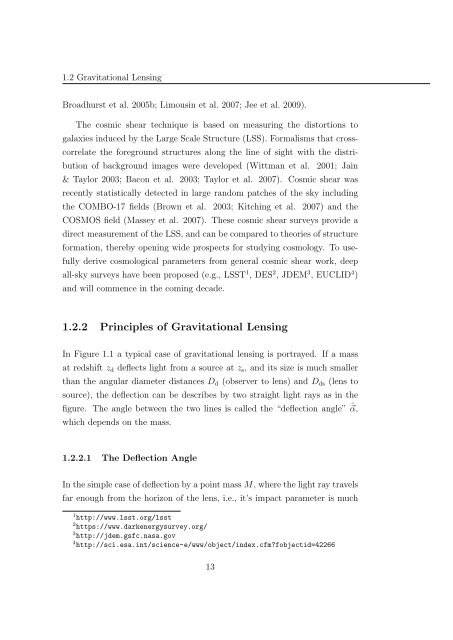Mass and Light distributions in Clusters of Galaxies - Henry A ...
Mass and Light distributions in Clusters of Galaxies - Henry A ...
Mass and Light distributions in Clusters of Galaxies - Henry A ...
Create successful ePaper yourself
Turn your PDF publications into a flip-book with our unique Google optimized e-Paper software.
1.2 Gravitational Lens<strong>in</strong>g<br />
Broadhurst et al. 2005b; Limous<strong>in</strong> et al. 2007; Jee et al. 2009).<br />
The cosmic shear technique is based on measur<strong>in</strong>g the distortions to<br />
galaxies <strong>in</strong>duced by the Large Scale Structure (LSS). Formalisms that crosscorrelate<br />
the foreground structures along the l<strong>in</strong>e <strong>of</strong> sight with the distribution<br />
<strong>of</strong> background images were developed (Wittman et al. 2001; Ja<strong>in</strong><br />
& Taylor 2003; Bacon et al. 2003; Taylor et al. 2007). Cosmic shear was<br />
recently statistically detected <strong>in</strong> large r<strong>and</strong>om patches <strong>of</strong> the sky <strong>in</strong>clud<strong>in</strong>g<br />
the COMBO-17 fields (Brown et al. 2003; Kitch<strong>in</strong>g et al. 2007) <strong>and</strong> the<br />
COSMOS field (<strong>Mass</strong>ey et al. 2007). These cosmic shear surveys provide a<br />
direct measurement <strong>of</strong> the LSS, <strong>and</strong> can be compared to theories <strong>of</strong> structure<br />
formation, thereby open<strong>in</strong>g wide prospects for study<strong>in</strong>g cosmology. To usefully<br />
derive cosmological parameters from general cosmic shear work, deep<br />
all-sky surveys have been proposed (e.g., LSST 1 , DES 2 , JDEM 3 , EUCLID 4 )<br />
<strong>and</strong> will commence <strong>in</strong> the com<strong>in</strong>g decade.<br />
1.2.2 Pr<strong>in</strong>ciples <strong>of</strong> Gravitational Lens<strong>in</strong>g<br />
In Figure 1.1 a typical case <strong>of</strong> gravitational lens<strong>in</strong>g is portrayed. If a mass<br />
at redshift z d deflects light from a source at z s , <strong>and</strong> its size is much smaller<br />
than the angular diameter distances D d (observer to lens) <strong>and</strong> D ds (lens to<br />
source), the deflection can be describes by two straight light rays as <strong>in</strong> the<br />
figure. The angle between the two l<strong>in</strong>es is called the “deflection angle” ˆ⃗α,<br />
which depends on the mass.<br />
1.2.2.1 The Deflection Angle<br />
In the simple case <strong>of</strong> deflection by a po<strong>in</strong>t mass M, where the light ray travels<br />
far enough from the horizon <strong>of</strong> the lens, i.e., it’s impact parameter is much<br />
1 http://www.lsst.org/lsst<br />
2 https://www.darkenergysurvey.org/<br />
3 http://jdem.gsfc.nasa.gov<br />
4 http://sci.esa.<strong>in</strong>t/science-e/www/object/<strong>in</strong>dex.cfm?fobjectid=42266<br />
13
















